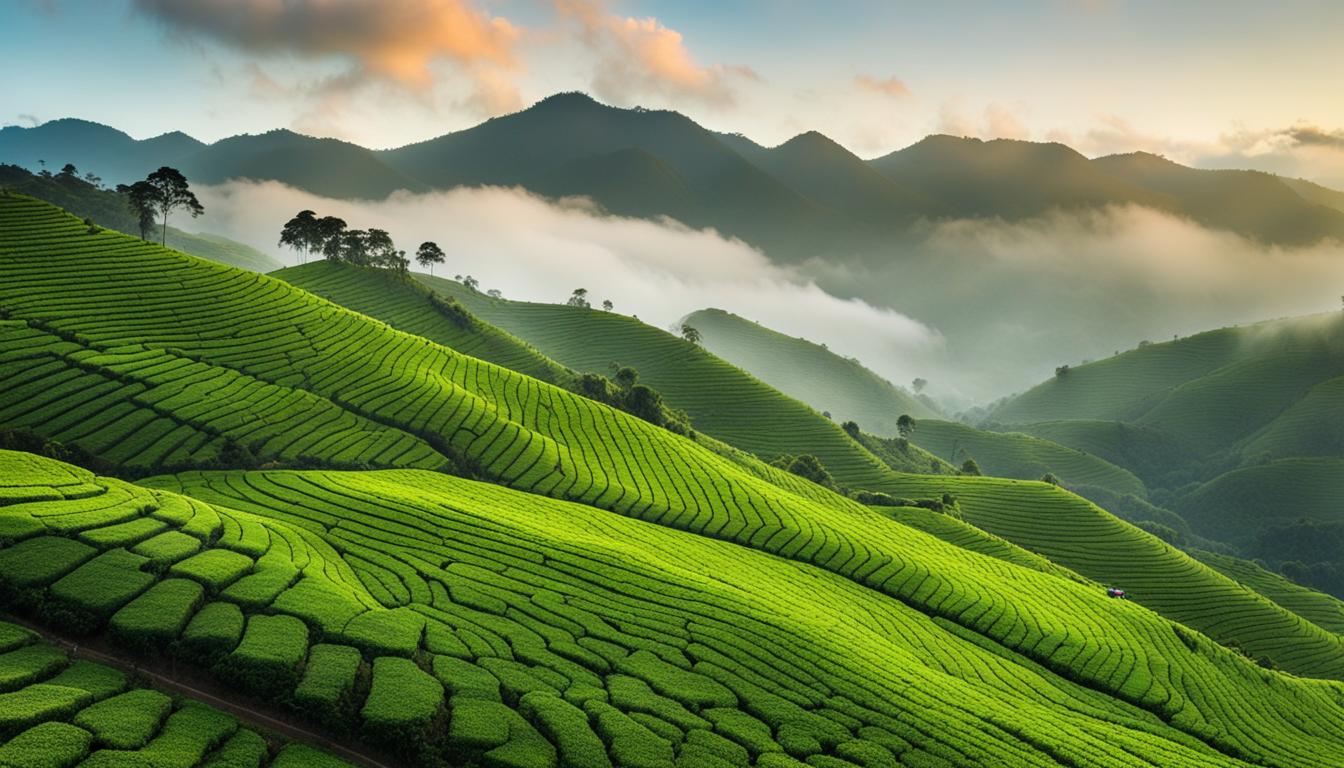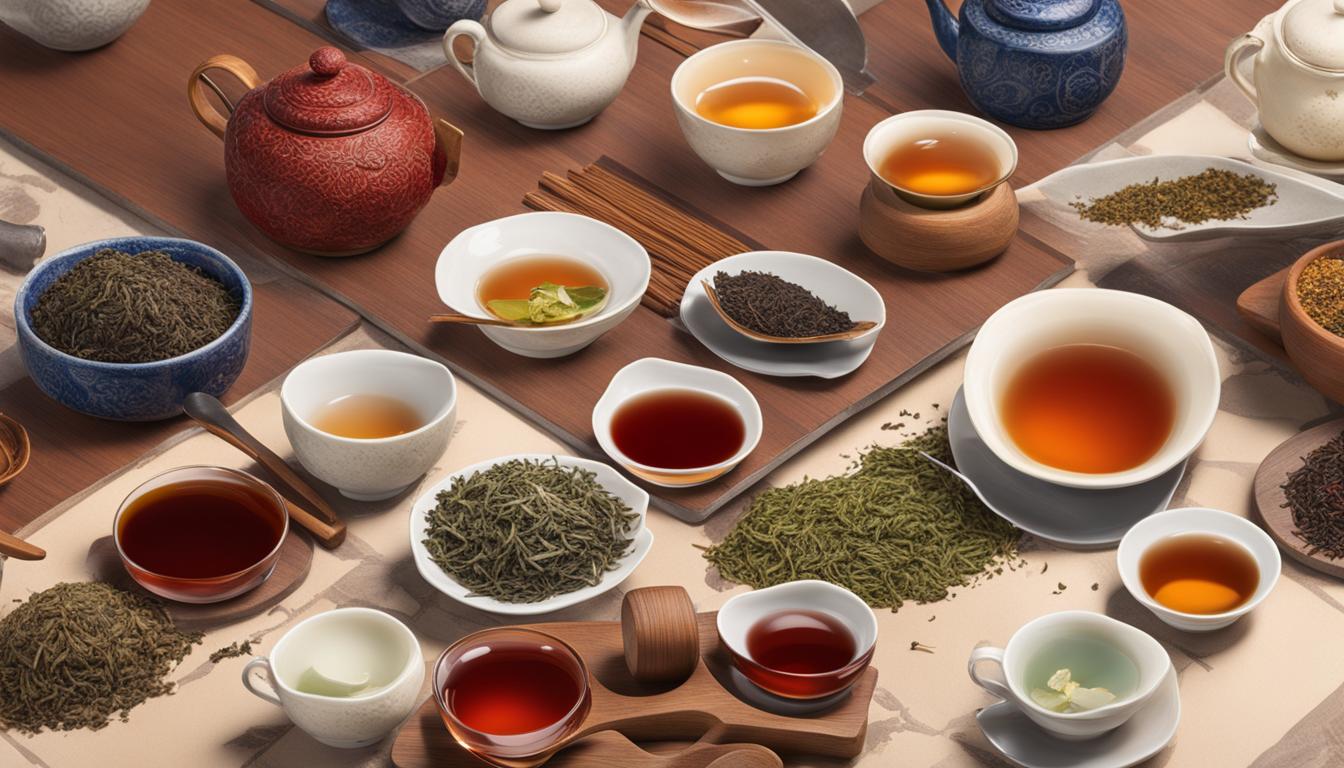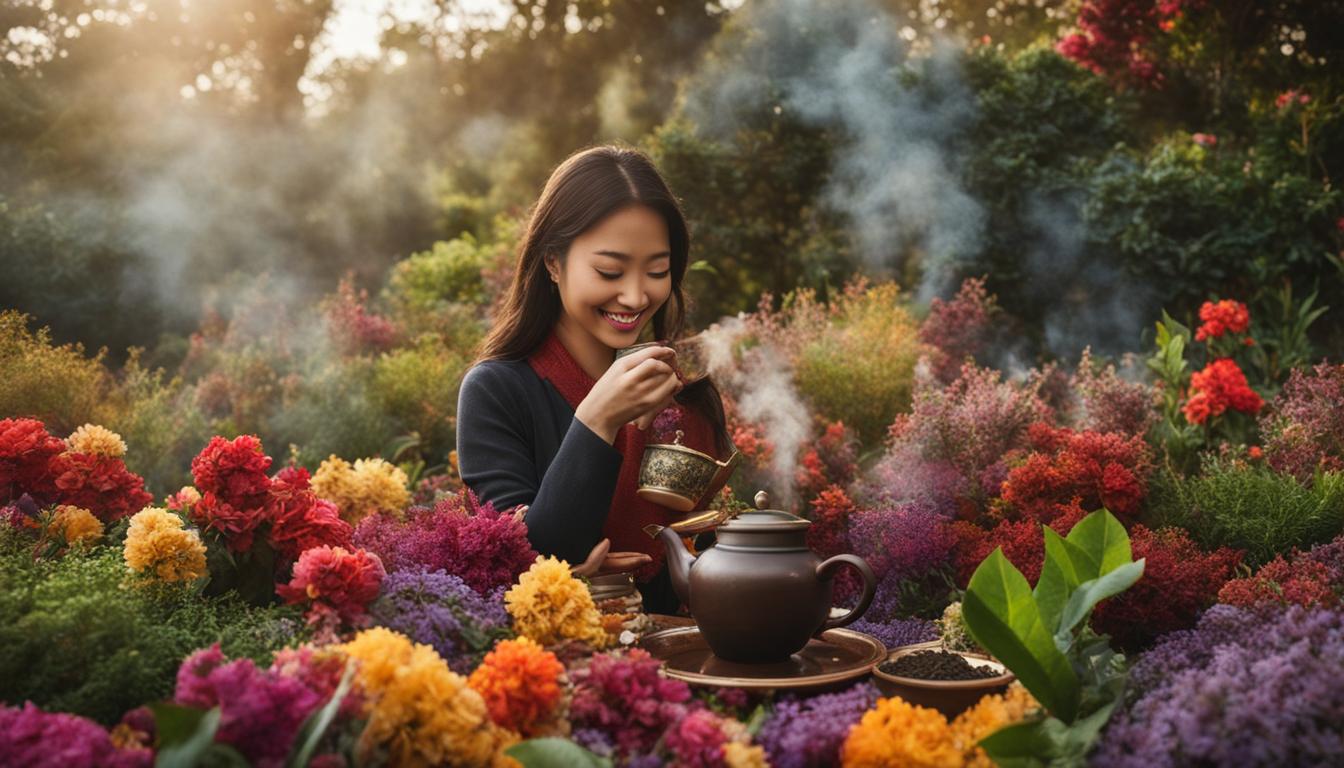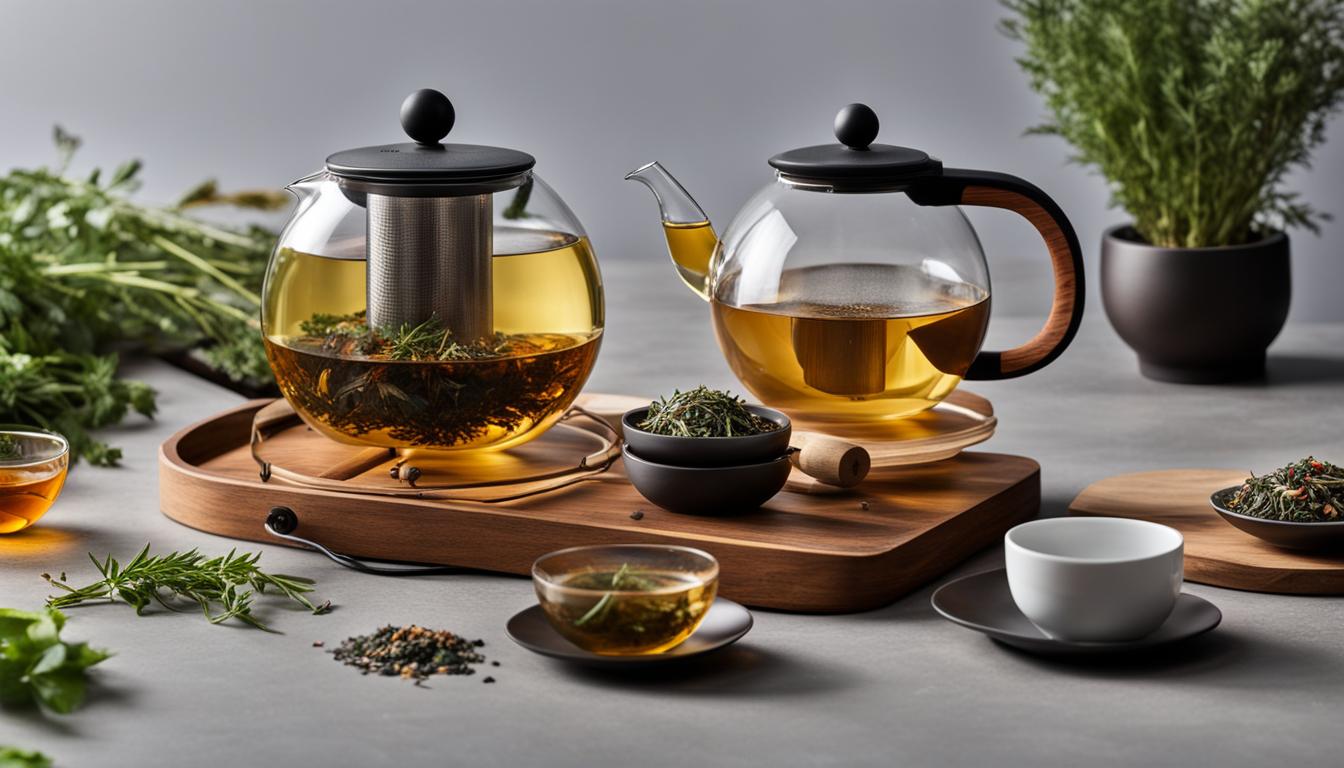Welcome to our exploration of the fascinating world of tea flavor profiles and the intriguing influence of terroir. Just like the concept of terroir in wines, tea enthusiasts are discovering that the geography, climate, and ecosystem of a tea-growing region play a pivotal role in shaping the taste and characteristics of their beloved beverage. So, grab a cup of your favorite tea and join us on this flavorful journey!
Key Takeaways:
- Terroir refers to the unique taste imparted by the geography, climate, and ecosystem of a tea-growing region.
- Different types of tea have distinct characteristics influenced by their terroir, just like wines.
- Factors such as soil composition, water sources, local ecosystem, weather conditions, climate, and elevation all contribute to tea terroir.
- Soil composition and biodiversity in the tea-growing region also play a crucial role in tea flavor.
- The cultural and historical context of a tea-growing region is intricately tied to its terroir and influences tea perception.
Understanding Terroir in Tea
Terroir in tea is a fascinating concept that plays a significant role in shaping the flavor profiles of different teas. By studying the impact of terroir on tea, we gain a deeper understanding of how geography, climate, and local ecosystems influence the taste of this beloved beverage.
Soil composition is one of the key factors that contribute to tea terroir. Different types of soil, such as clay-like or volcanic soil, can impart unique flavors to the tea leaves. Additionally, the mineral content in water sources also has an influence on the chemical composition of tea plants, further contributing to the distinct characteristics of teas from specific regions.
The local ecosystem, including the surrounding plants, flowers, and even insects, also plays a role in tea flavor. The tea plant absorbs aromas from the air, which are then reflected in the taste of the leaves. This interaction between the tea plant and its environment creates a complex and dynamic flavor profile that is unique to each tea terroir.
Weather conditions, such as sunlight, rain, mist, and temperature, also contribute to the development of tea leaves and their resulting flavors. These factors affect the growth rate, chemical composition, and overall quality of the tea leaves, resulting in variations in flavor profiles based on the terroir of the tea-growing region.
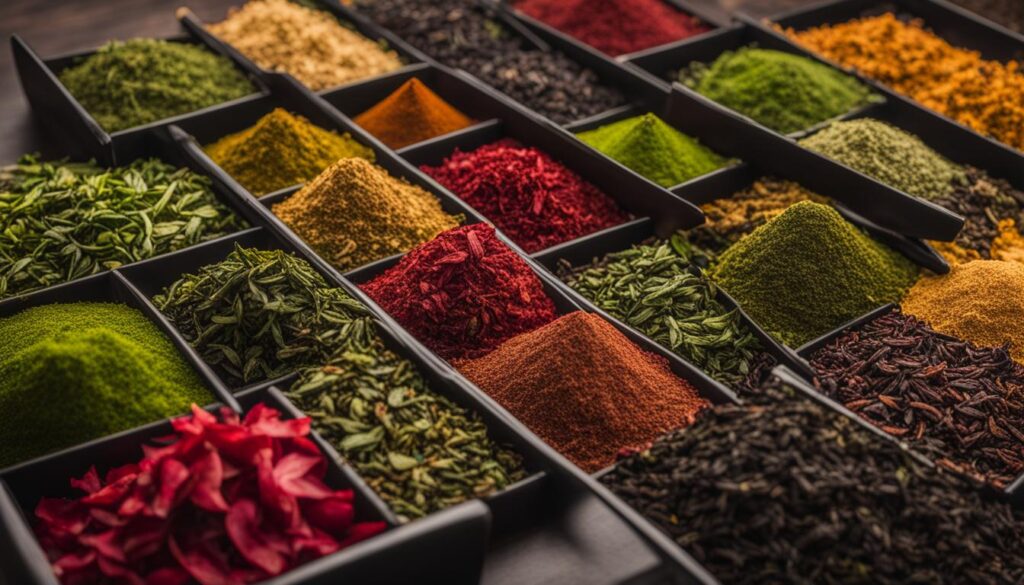
The Role of Climate and Elevation
When it comes to exploring terroir in tea flavors, there are two crucial factors that significantly influence the taste: climate and elevation. These elements work in harmony to create the distinct flavor profiles found in teas from different regions.
Climate plays a vital role in shaping tea terroir. Teas grown in warm and humid climates often have complex and subtle aromas, as the favorable conditions allow for a more diverse range of flavors to develop. On the other hand, teas grown in cooler climates tend to have sweeter notes. The temperature, sunlight, rain, and mist all contribute to the unique growth and development of tea leaves, ultimately impacting their taste.
In addition to climate, elevation also plays a significant role in tea flavor. As tea plants are grown at higher altitudes, the slower growth and increased exposure to sunlight lead to higher chlorophyll content in the leaves. This results in a rich, floral flavor in the tea. The altitude also affects the overall environmental conditions, such as temperature, air quality, and soil drainage, all of which contribute to the unique flavor profiles and aromatic characteristics of teas from different regions.
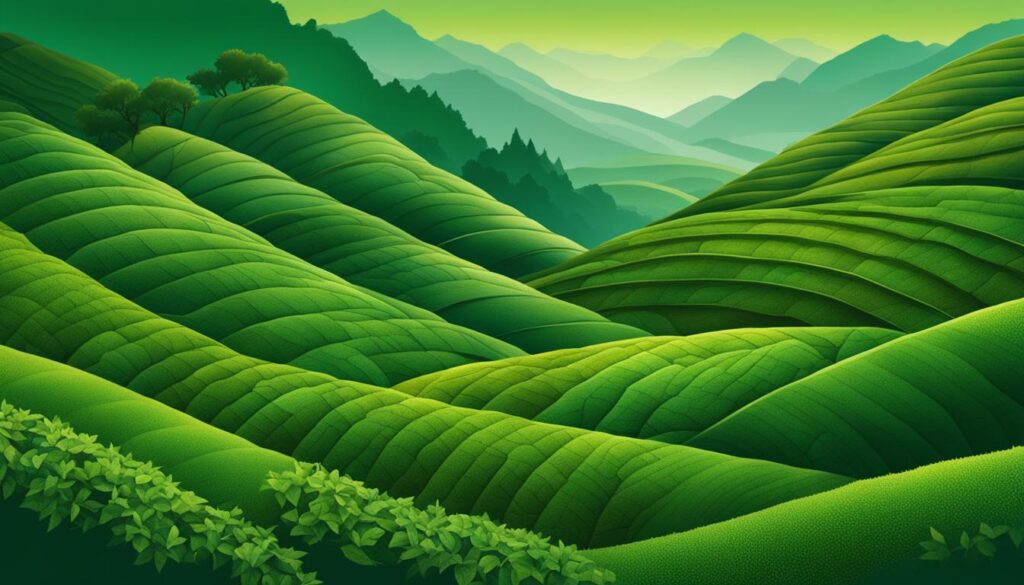
In conclusion, exploring the role of climate and elevation in tea terroir is essential for understanding the diverse flavors of teas from different regions. The combination of warm or cool climates, along with varying altitudes, creates a wide range of flavor profiles that tea enthusiasts can enjoy and appreciate. So, the next time you sip a cup of tea, take a moment to ponder the influence of climate and elevation on its unique taste.
The Influence of Soil and Biodiversity
When it comes to understanding the impact of terroir on tea taste, two important factors to consider are soil composition and biodiversity in the tea-growing region. The type of soil plays a significant role in shaping the flavors of tea, with different soil types imparting unique characteristics to the final product. For example, tea grown in clay-like soil may have a more robust and earthy flavor, while volcanic soil can lend a subtle mineral note to the tea’s taste.
Beyond soil composition, the flora and fauna in the tea-growing region also contribute to the tea’s flavor profile. The plants, flowers, and insects present in the area can influence the flavors absorbed by the tea leaves, adding complexity and nuance to the final brew. This biodiversity creates a diverse and complex ecosystem that impacts the taste of the tea.
“The biodiversity of a tea-growing region creates an intricate web of interactions that shape the flavor of the tea. It’s like a symphony of different elements coming together to create a unique tasting experience,” says tea expert Jane Smith.
Understanding the influence of soil and biodiversity on tea taste allows us to appreciate the intricacies and diversity of teas from different regions. It highlights the importance of preserving and protecting the natural environment in which tea is cultivated, as these factors directly impact the flavor profiles that we enjoy.
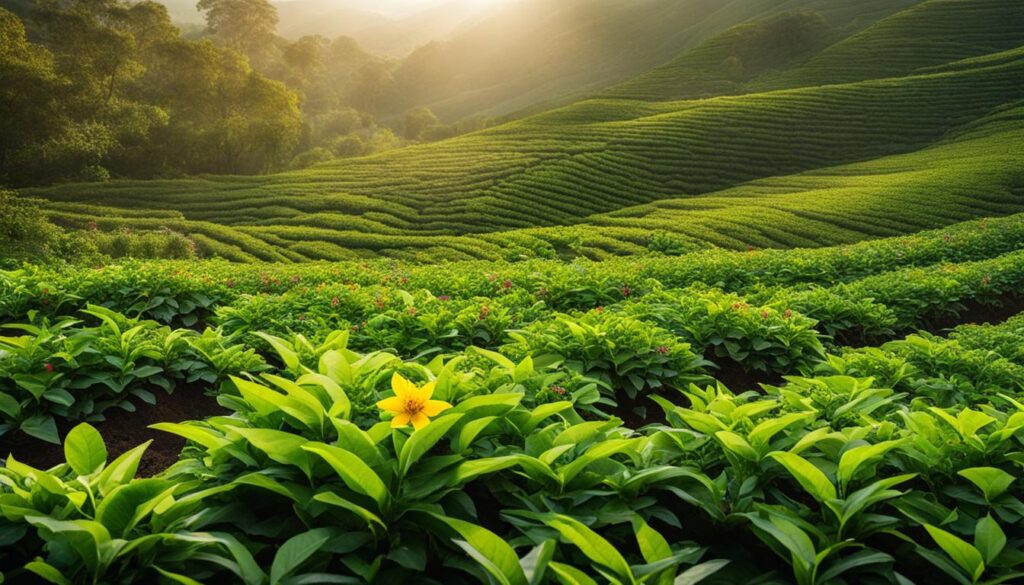
The Impact of Soil and Biodiversity on Tea Flavor
| Soil Type | Flavor Profile |
|---|---|
| Clay-like soil | Robust, earthy |
| Volcanic soil | Subtle mineral notes |
| Sandy soil | Light and delicate |
Biodiversity and Tea Flavor
- Flora: The plant species in the tea-growing region can contribute aromatic compounds and flavors to the tea leaves.
- Flowers: The presence of specific flowers can infuse the tea leaves with floral notes, adding a pleasant and fragrant character.
- Insects: Insects that coexist with the tea plants may leave behind residues or secretions that contribute to the tea’s flavor.
The Cultural and Historical Aspect
The cultural and historical context of a tea-growing region is intricately tied to its terroir. The reputation and perception of teas are influenced by factors such as traditional cultivation, processing techniques, and consumer biases. Certain regions become famous for specific teas, leading to preconceived notions of taste and quality. Moreover, the economic factors of a region, including pricing, can influence the quality and care put into tea production. All of these factors contribute to the flavor and perception of tea influenced by terroir.
Tea is deeply embedded in the cultural fabric of many countries, with unique customs and rituals associated with its consumption. For example, in Japan, the traditional tea ceremony is an important cultural practice that emphasizes harmony, respect, and tranquility. The ceremony showcases the beauty of tea preparation and elevates the tea-drinking experience. Similarly, in China, tea has historical significance and is often served during special occasions or as a gesture of hospitality.
Understanding the cultural and historical aspects of tea-growing regions enhances our appreciation for the flavors and traditions associated with different teas. It allows us to connect with the rich heritage and stories behind each cup of tea we enjoy. The influence of culture and history on tea flavor is a testament to the multifaceted nature of terroir and its impact on the sensory experience of tea enthusiasts.
The Role of Tradition in Tea Flavor
Tradition plays a significant role in shaping the flavor profiles of teas. The cultivation and processing techniques passed down through generations contribute to the unique characteristics of teas from specific regions. For example, in Darjeeling, India, the tradition of plucking tea leaves at specific times of the year, known as flushes, is believed to enhance the delicate floral notes of Darjeeling tea. Similarly, the long-standing practice of hand-rolling tea leaves in Taiwan creates tightly curled oolong teas with complex flavors.
“Tea traditions are like a living heritage, preserving the essence of flavors developed over centuries. They provide a link between the past and present, showcasing the artistry and expertise of tea producers.”
These traditions not only shape the flavors of teas but also contribute to the overall cultural identity of tea-growing regions. They represent the dedication and skill of tea artisans who strive to preserve and innovate within their respective traditions. By understanding and appreciating these traditions, we can fully immerse ourselves in the world of tea and savor its rich history and flavors.
Terroir’s Influence in Different Tea-Producing Countries
Terroir is a fascinating concept that shapes the flavor profiles of teas from different regions around the world. Each tea-producing country has its own unique terroir, resulting in distinct taste variations. Let’s take a closer look at how terroir influences the flavors of teas from various countries.
In China, terroir plays a significant role in the production of teas like Yunnan, Fujian, and Zhejiang. Yunnan tea, for example, is known for its earthy, robust flavor, influenced by the region’s rich and fertile soil. Fujian teas, on the other hand, have a delicate and floral character, in part due to the coastal terroir and misty climate. Zhejiang teas, especially the famous Longjing (Dragon Well) tea, are renowned for their fresh, grassy taste, attributed to the region’s hilly terrain and humid climate.
India also boasts unique terroirs that contribute to the country’s diverse tea flavors. The Darjeeling region, located in the foothills of the Himalayas, produces teas with a muscatel flavor and exquisite aroma. Assam, with its low-lying plains and tropical climate, is famous for its bold and malty teas. Nilgiri teas, grown in the Blue Mountains of Southern India, offer a refreshing and brisk character, thanks to the region’s cool and misty terroir.
Sri Lanka, formerly known as Ceylon, is another tea-producing country where terroir plays a vital role. The island nation’s diverse climatic conditions and elevation variations result in a wide range of Ceylon teas. From the high-grown teas of Nuwara Eliya with their bright and delicate profiles, to the medium-grown teas of Dimbula with their full-bodied flavors, and the low-grown teas of Ruhuna with their rich and robust characteristics, Sri Lanka showcases the impact of terroir on tea.
Table: Flavor Variations by Terroir in Different Tea-Producing Countries
| Country | Tea Region | Flavor Profile |
|---|---|---|
| China | Yunnan | Earthy, Robust |
| China | Fujian | Delicate, Floral |
| China | Zhejiang | Fresh, Grassy |
| India | Darjeeling | Muscatel, Aromatic |
| India | Assam | Bold, Malty |
| India | Nilgiri | Refreshing, Brisk |
| Sri Lanka | Nuwara Eliya | Bright, Delicate |
| Sri Lanka | Dimbula | Full-bodied |
| Sri Lanka | Ruhuna | Rich, Robust |
Japan and Taiwan are also known for their distinct tea terroirs. Japan’s Shizuoka region produces teas with a grassy and vegetal flavor, while Uji teas are known for their deep umami notes and vibrant green color. Taiwan’s terroirs, particularly in the Dong Ding region and the high mountain areas, result in oolong teas with complex floral and fruity aromas. The variations in terroir across these countries showcase the remarkable range of flavors that can be found in teas.
Studying the impact of terroir on tea allows us to appreciate the intricate connection between nature, geography, and flavor. It highlights the diversity of tea and offers a deeper understanding of the craft and artistry behind each cup. So, the next time you sip a cup of tea, take a moment to ponder the terroir that has influenced its unique flavor.
Conclusion
In conclusion, exploring the impact of terroir on tea flavors reveals the intricate relationship between the environment and our favorite brews. By understanding how climate, elevation, soil, biodiversity, and human factors shape tea’s taste, we can truly appreciate the diversity and complexities found in teas from different regions.
Terroir is more than just a buzzword; it is a concept that showcases the art and science behind tea production. Each cup of tea tells a story, capturing the essence of its terroir. Whether it’s the earthy notes of a Darjeeling from India or the delicate floral aroma of a high mountain tea from Taiwan, terroir adds depth and uniqueness to our tea-drinking experience.
So, the next time you embark on a tea-tasting journey, take a moment to explore the terroirs behind your favorite teas. Dive into the world of tea terroir, and you’ll discover a whole new level of appreciation for the flavors that nature and human expertise can create. Cheers to exploring the fascinating world of terroir in tea flavors!
FAQ
What is terroir, and how does it influence tea flavor?
Terroir refers to the unique taste imparted by the geography, climate, and ecosystem of a tea-growing region. It influences the flavor profiles of tea by factors such as soil composition, water sources, local ecosystem, weather conditions, and cultural and historical context.
How does climate and elevation affect tea terroir?
Different climates and elevations result in distinct flavor profiles in tea. Warm and humid climates tend to produce teas with complex and subtle aromas, while cooler climates often result in sweeter notes. Higher elevations lead to slower growth, increased chlorophyll content, and a rich, floral flavor.
What role does soil composition play in terroir?
Soil composition is crucial in defining terroir. Different types of soil, such as clay-like or volcanic soil, impart unique flavors to tea. The flora, fauna, and biodiversity in the tea-growing region also contribute to the tea’s taste.
How does the cultural and historical aspect influence terroir?
The reputation and perception of teas are influenced by factors such as traditional cultivation, processing techniques, and consumer biases. Certain regions gain fame for specific teas, leading to preconceived notions of taste and quality. Economic factors, such as pricing, can also impact the quality and care put into tea production.
In which tea-producing countries can we find terroir’s influence?
Terroir’s influence can be found in teas from various regions around the world. China has regions like Yunnan, Fujian, and Zhejiang, each with their unique characteristics. India showcases terroirs like Darjeeling, Assam, and Nilgiri. Sri Lanka’s terroirs contribute to the diversity of Ceylon tea. Japan’s tea terroirs include Shizuoka and Uji, known for their wide range of aromas and tastes. Taiwan highlights its terroirs through teas like Dong Ding oolong and high mountain teas.

